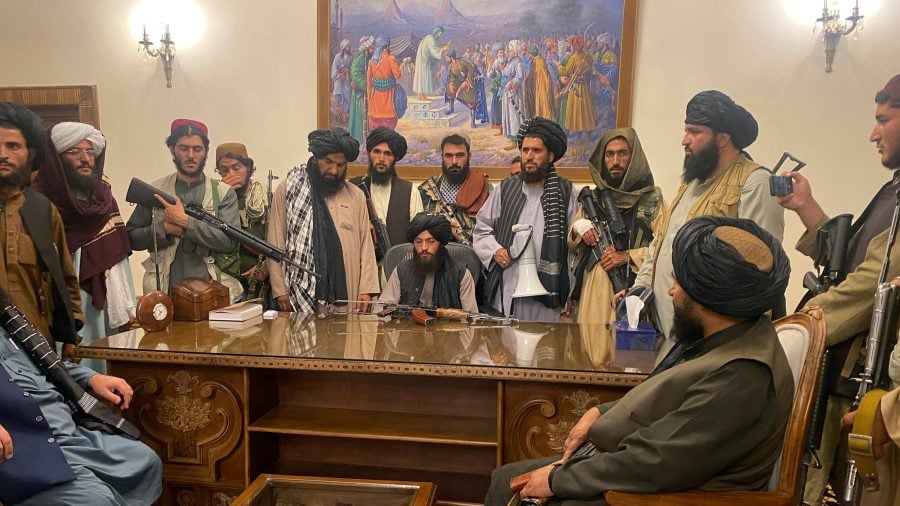By Hassan Aslam Shad
Kabul has fallen and with it, one hopes, the last remnants of US and Indian hubris and arrogance. But Kabul’s fall has also jettisoned the global moment of sombre reflection one expected in the aftermath of a Taliban takeover of Afghanistan.
How did we get here? That the Taliban blitzkrieg was not foreseen by global pundits and armchair analysts would be an understatement. They completely bungled this one up. But the seeds of the Taliban’s unprecedented takeover of Afghanistan had been sown much earlier. Since the early days, we were told the familiar story: Taliban are “barbarians” and a recurring threat to the civilized world. The world, therefore, had to act, and act fast.
And act, it did. Starting in 2002, we saw the US and NATO launch the most expensive military campaign in human history against the Taliban and Al-Qaeda. While the military campaign hit the Taliban hard, it far from led to its rout. Instead, what we saw were the deaths of thousands of Afghan civilians through raining daisy cutters, carpet bombs, and swarming drones.
This inevitably turned public sentiment against the US and NATO forces. More than anything, Afghanistan ended up being set back by decades if not centuries. And then came “nation-building”. Billions of dollars were poured into Afghanistan to “reconstruct” and “liberate” it.
Hamid Karzai and Ashraf Ghani were the vicegerents imported into Afghanistan to magically make this happen. But any real progress was nowhere to be seen, save within a few miles of Kabul’s diameter which its elite chose to call home. As Ashraf Ghani predictably failed to coalesce Afghan society into a coherent structure, the Taliban bided its time and regrouped.
Afghanistan also became the new battleground between India and Pakistan away from the scenic Himalayas where they have traditionally locked horns over Kashmir. The imbroglio in Afghanistan got further complicated because of the various militant groups and terrorist factions that found a cozy shelter in Afghanistan away from home. Come to China and Russia, who have an axe to grind against the US, and the stakes got higher for and in Afghanistan.
The result was paradoxical: Afghanistan ‘interested’ everyone but not enough for anyone to consider investing in it for the long term. In South Asia’s new “Wild Wild West”, everyone was looking to fend for themselves.
So, what possibly explains the speed of the dismantling of the Ashraf Ghani government and the Taliban takeover?
Hard to tell if the countries involved are to be believed. India and the now-former Ghani government protagonists blame the Taliban takeover on Pakistan’s connivance. Pakistan, on the other hand, sees it as a manifestation of the “will” of the majority Afghans who were deeply aggrieved against the corrupt Ghani government and the US and NATO campaign.
The world has, so far, refused to acknowledge the legality of the Taliban’s takeover of Afghanistan. The cognitive dissonance of not knowing how the Taliban takeover could have happened at such speed means that it will be some time before we see countries accept the new Taliban-ruled order. But we can reasonably expect a rather swift “recognition” of the Taliban dispensation in the near future. The world has a rather predictable proclivity towards accepting the rule of power!
And yet the world continues to miss the forest for the trees. Let’s start with the labeling exercise. In the aftermath of the 911 attacks, the Taliban were called “terrorists” without realizing that it is impossible to define who the Taliban are: if anything, an indigenous group comprising of a number of disparate groups with not necessarily the same political objectives.
Interestingly, the “terrorists” label remained affixed on the Taliban until the US and NATO realized that the costs of war could no longer be absorbed and an exit from
Afghanistan was inevitable. Thereafter, there was a gradual peeling off of this label. We saw a “good” Taliban emerge from the shadows with whom the US and the West could finally negotiate. In a repeat of the 80s when the “Mujahideen” (yesteryear’s Taliban) became the US’s blue-eyed boy, we once again saw the West bend the norms to suit its interests.
The result was more confusion – and further emboldening of the Taliban. Despite its archaic and brutal practices in the past which tarred the Taliban’s reputation, there can be no denying that the Taliban derives its legitimacy by belonging to the Pashtun ethnic majority of Afghanistan and from its successfully neutralizing the world’s two most powerful military machines (US and USSR). That the Taliban 2.0 can now adorn its CV with the boast of vanquishing the US means that the world should expect a more resilient group that will aggressively pursue its geopolitical goals.
In other words, Taliban 2.0 is not Taliban 1.0. Taliban 2.0 is battle-hardened, has been through the vagaries of armed conflict and international diplomacy, and resurged as the single most dominant power in Afghanistan. Importantly, the world needs to learn a lesson or two from its previous mistakes. Any future labeling exercise of the Taliban will be met with stiff resistance and potentially dire consequences. The world, therefore, needs to separate the “people” (the Taliban) from the “problem” (the plethora of issues faced by the ordinary Afghan).
The West’s project “freedom” and “liberation” failed in Afghanistan precisely because there was no one to liberate. If there is anything the Afghans need to be liberated from, it is from the shackles of poverty and illiteracy. While accepting that the Taliban is a reality that cannot be wished away, the world needs to focus on the long-term sustainable development of Afghanistan. As simplistic as this may sound, there is no other way out.
There are clear signs that Chinese and Russian influence will now increase in Afghanistan. This is not for altruistic reasons but because both countries have an axe to grind against the US – although, admittedly, China, is also looking to anchor the BRI in Afghanistan for a transcontinental Eurasian connectivity. This is Afghanistan’s best hope for economic integration within a global framework similar to the US Marshall Plan after World War II. It remains to be seen whether the Taliban will engage with the US in the future.
While US will be likely to eschew opposing Chinese and Russian investment in Afghanistan, its influence will wane but not entirely disappear. The US still holds the global purse strings. In a country where treacherous switching of sides when shown the greenback can happen in the blink of an eye, in a remarkable twist of fate, it is now the Taliban that be thinking about how to ringfence against regional factions that can threaten its rule.
This brings me to why the Taliban 2.0 may be a new blockbuster rather than a sequel of Taliban 1.0. Running a country is not the same as running an insurgency. The Taliban will have an interest in improving the lives of ordinary Afghans to avoid the same dissatisfaction that led to the support for the Taliban to take-over Afghanistan. There are some indications that the Taliban has evolved over the last 20 years: it has very astutely used diplomatic leverage to bide time and regroup and, in the process, paved the way for this latest sweeping blitzkrieg.
So far, there are no reports of any civilian killings by the Taliban. The Taliban has also reportedly allowed women to continue working (however, much would remain to be seen on this front). So far, there have been no attacks on journalists or places of religious worship. Most importantly, the Taliban has announced a general amnesty for government officials and invited women’s participation in the government. These are surprisingly reassuring developments. If the Taliban is to anchor itself in the global system, it cannot be seen demolishing Bamiyan Buddhas or flogging women. Such brutal and archaic practices have no place in today’s world. The Taliban seem to have learned some hard lessons.
And finally, a few words on Pakistan’s options and where it stands vis-à-vis the dramatic and unprecedented developments on its Western border.
Pakistan has so far trodden the path tactfully and, shall I say, with strategic restraint. Starting from the Prime Minister down to the country’s NSA, Pakistan has repeatedly reiterated that it is will not take any sides and that it stands for peace and stability in Afghanistan. In the recent National Security Committee huddle, Pakistan urged all stakeholders to reach a political settlement, respect the rule of law, protect human rights, and ensure that Afghan soil is not used by any terrorist organization against any country.
Pakistan has also offered to continue working with the international community and Afghan stakeholders to facilitate an inclusive political settlement. That Pakistan continues to take this position in the future is very important for the country. The world is closely watching Afghanistan but even more closely, Pakistan. Pakistan will need to continue the creative destruction of the “strategic depth” narrative which has been Pakistan’s “guilt by association” bane. To peel off layers from this presumption of guilt, Pakistan will need to steadfastly remain tethered to a posture of “neutrality” towards Afghanistan. It won’t be too long before the world recognizes the Taliban or a future dispensation in which the Taliban has the main role.
At an appropriate time, Pakistan can recognize the Taliban “as a matter of routine” without being seen to be going out of its way. Until such time, a bit of strategic elusiveness and tactful restraint can help Pakistan wipe off the reputational taint and burnish its global credentials.
The war in Afghanistan is far from over – especially for Pakistan. Pakistan’s regional integration cannot be complete without a peaceful and stable Afghanistan. The world will never digest Pakistan’s historic concerns towards Afghanistan that dictated its policy choices over the years. How would another country faced with an existential crisis like Pakistan have acted in similar circumstances? But this isn’t the time for discussing the past.
What should matter to Pakistan is whether it can successfully turn a new page with Afghanistan and with the world on Afghanistan. Pakistan will need to continue reminding everyone that Pakistan’s only “leverage” over the Taliban is its success in handholding and guiding the Taliban to the negotiating table and convincing it to engage with world powers (US, China, and Russia). Beyond this, any further Pakistani leverage will require concerted global support.
The future of Afghanistan and resultingly that of Pakistan are inextricably tied. The fog of war is far from over. But what is blurry today will become clearer in the days to come. The body blow dealt with the US and India in Afghanistan is something Pakistan has reason to rejoice – for now. But Pakistan just got dealt a new set of challenges that can’t be wished away. Beyond Pakistan’s immediate concern that TTP shouldn’t rear its ugly head in Pakistan for a “reverse strategic depth”, Pakistan’s end game should be a stable and prosperous Afghanistan that witnesses organic and long-term economic growth. Resurrecting fallen Kabul will be a gargantuan task for Pakistan, but it is something Pakistan will have to undertake with or without the help of its allies.
Hassan Aslam Shad is an international lawyer based in the Middle East. He is a legal director at a leading international law firm and a graduate of Harvard Law School, U.S.A. He can be reached at: [email protected] Twitter: @HassShad

US reaches out to Pakistan amid rapidly changing situation in Afghanistan










